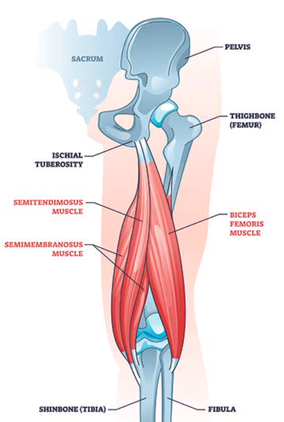Do your hamstrings feel tight and touching your toes just a pipe dream? If you’ve ever thought inflexible hamstrings could play a role in back pain and spinal health, and vice versa – you’re right.WHAT DO THE HAMSTRINGS DO?
The hamstring is the name given to a set of three muscles; together, they form the muscle group at the back of each thigh. These muscles originate at the pelvis and attach to the lower part of your knee. Think of them like an elastic band. As the band is pulled tighter, your thigh is drawn backward and your knee is bent. In anatomical terms, the hip is extended and the knee is flexed. This muscle group is used often. Gentler contraction enables you to stand and maintain an erect posture. Your hamstrings help to support a straight leg and upright pelvis. Stronger contraction allows you to put your leg into action: to walk, jog, run, jump, squat. But you cannot use this muscle group without an effect on your pelvis. After all, the two are connected. HOW DO TIGHT HAMSTRINGS AFFECT THE SPINE? From a biological and chiropractic perspective, the pelvis and spine are closely linked to the hamstrings. We know that hamstring tension changes how quickly the muscles in your lower back turn on and off. This affects function. Tense hamstrings lead to an altered lumbar curve and can trigger low back pain. Lumbar and pelvic adjustments may help increase hamstring flexibility. In short, when your hamstrings are too tight or your spinal joints aren’t working well, pressure on both increases. Dysfunction and injuries can occur. That’s why the term ‘back- related hamstring injury' was coined. But, when spinal dysfunction and “stuck” joints are corrected, these muscles relax. Injury may recover or, better yet, be prevented. WHY DO HAMSTRINGS BECOME TIGHT? Overuse, lack of stretching, poor posture, and individual anatomy each play a role. Different muscles designed to stabilise your body, including your spine, can also become weak. This may lead to hamstrings seeking to compensate. These weakened muscles can also stress spinal joints which, as already discussed, can then affect hamstring tension. Yes, it is a complicated web! So, how can you know if your hamstrings are too tight? As a simple test, sit in a chair. Push your bottom to the back. Keep your spine upright and face forward. Now, straighten your left knee and pull your toes toward your body. Then, perform on the right. On either side, do you feel tightness in the back of your thigh? If you do, speak to us. While this is a basic test, it’s a good starting point. Hamstring tightness is a significant problem. Linked to low back pain, injury, and a dysfunctional spine, it should not be ignored. The sooner you begin appropriate care, the sooner this problem can be corrected.
0 Comments
Leave a Reply. |
AuthorAdam's Back is a team of dedicated complimentary health professionals. Our aim is to support you in finding drug-free solutions for better health. Archives
July 2024
Categories |
Search by typing & pressing enter


 RSS Feed
RSS Feed